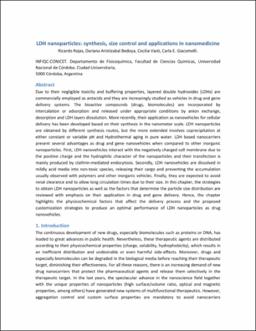| dc.contributor.author | Rojas Delgado, Ricardo | |
| dc.contributor.author | Aristizábal Bedoya, Dariana | |
| dc.date.accessioned | 2023-11-13T15:21:12Z | |
| dc.date.available | 2023-11-13T15:21:12Z | |
| dc.date.issued | 2015 | |
| dc.identifier.isbn | 978-1-63482-040-0 | |
| dc.identifier.uri | http://hdl.handle.net/11086/549852 | |
| dc.description.abstract | Due to their negligible toxicity and buffering properties, layered double hydroxides (LDHs) are commercially employed as antacids and they are increasingly studied as vehicles in drug and gene delivery systems. The bioactive compounds (drugs, biomolecules) are incorporated by intercalation or adsorption and released under appropriate conditions by anion exchange, desorption and LDH layers dissolution. More recently, their application as nanovehicles for cellular delivery has been developed based on their synthesis in the nanometer scale. LDH nanoparticles are obtained by different synthesis routes, but the more extended involves coprecipitation at either constant or variable pH and Hydrothermal aging in pure water. LDH based nanocarriers present several advantages as drug and gene nanovehicles when compared to other inorganic nanoparticles. First, LDH nanovehicles interact with the negatively charged cell membrane due to the positive charge and the hydrophilic character of the nanoparticles and their transfection is mainly produced by clathrin-mediated endocytosis. Secondly, LDH nanovehicles are dissolved in mildly acid media into non-toxic species, releasing their cargo and preventing the accumulation usually observed with polymers and other inorganic vehicles. Finally, they are expected to avoid renal clearance and to allow long circulation times due to their size. In this chapter, the strategies to obtain LDH nanoparticles as well as the factors that determine the particle size distribution are reviewed with emphasis on their application in drug and gene delivery. Hence, the chapter highlights the physicochemical factors that affect the delivery process and the proposed customization strategies to produce an optimal performance of LDH nanoparticles as drug nanovehicles. | es |
| dc.description.uri | https://www.novapublishers.com/catalog/product_info.php?products_id=53541&osCsid=469ab46320a31868fd228af23f949441 | |
| dc.format.medium | Impreso; Electrónico y/o Digital | |
| dc.language.iso | eng | es |
| dc.rights | Attribution-NonCommercial-ShareAlike 4.0 International | * |
| dc.rights.uri | http://creativecommons.org/licenses/by-nc-sa/4.0/ | * |
| dc.title | LDH nanoparticles: synthesis, size control and applications in nanomedicine | es |
| dc.type | bookPart | es |
| dc.description.fil | Fil: Aristizábal Bedoya, Dariana. Universidad Nacional de Córdoba. Facultad de Ciencias Químicas. Departamento de Fisicoquímica; Argentina. | es |
| dc.description.fil | Fil: Rojas Delgado, Ricardo. Universidad Nacional de Córdoba. Facultad de Ciencias Químicas. Departamento de Fisicoquímica; Argentina. | es |
| dc.description.fil | Fil: Giacomelli, Carla Eugenia. Universidad Nacional de Córdoba. Facultad de Ciencias Químicas. Departamento de Fisicoquímica; Argentina. | es |
| dc.description.fil | Fil: Vasti, Cecilia . Universidad Nacional de Córdoba. Facultad de Ciencias Químicas. Departamento de Fisicoquímica; Argentina. | es |
| dc.journal.referato | Con referato | |
| dc.description.field | Nano-materiales (producción y propiedades) | |
| dc.book.city | New York | |
| dc.book.country | Estados Unidos | |
| dc.book.editorial | Nova Science Publisher | |
| dc.book.firstpage | 101 | |
| dc.book.lastpage | 120 | |
| dc.book.pages | 152 | |
| dc.book.role | Autor | |
| dc.book.title | Layered Double Hydroxides: Synthesis, Characterization and Applications | en |





